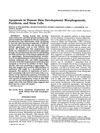TLDR c-Myc, Max, and Bin1 help hair follicle cells mature and die.
The study investigated the expression patterns of c-Myc, Max, and Bin1 in human anagen hair follicles. It was found that c-Myc was present in specific regions of the inner root sheath (IRS) where keratinocytes undergo terminal differentiation. These regions were identified as the lower ring (LR), upper ring (UR), and a newly discovered intermediate ring (IR). Max was observed in all three layers of the IRS, aligning with c-Myc-positive regions, while Bin1 was primarily found in Huxley's layer and the cuticle. The findings suggested that the differentiation of hair follicle layers involves the expression of genes within the 'Myc network', with c-Myc marking the transition to terminal differentiation and cell deletion.
140 citations
,
December 1998 in “Journal of Investigative Dermatology” Apoptosis in hair follicles varies by growth phase, with TGF-β possibly starting the catagen phase.
135 citations
,
October 1997 in “Journal of biological chemistry/The Journal of biological chemistry” Trichohyalin is modified by enzymes to form strong structures in hair cells.
42 citations
,
February 1996 in “Journal of Investigative Dermatology” Polyamines, especially spermidine, are essential for hair growth.
 253 citations
,
March 1994 in “Developmental dynamics”
253 citations
,
March 1994 in “Developmental dynamics” Apoptosis is essential for human skin development and forming a functional epidermis.
81 citations
,
May 1986 in “Journal of Investigative Dermatology”
10 citations
,
October 2000 in “PubMed” E6/E7 oncogenes in hair follicles cause continuous hair growth by skipping the resting phase.
 94 citations
,
February 1994 in “The journal of investigative dermatology/Journal of investigative dermatology”
94 citations
,
February 1994 in “The journal of investigative dermatology/Journal of investigative dermatology” EGF makes hair follicles grow longer but stops hair production.
59 citations
,
August 1981 in “PubMed” Trichilemmal keratinization is a unique process in hair follicles where the outer root sheath turns into keratin without a specific layer.

